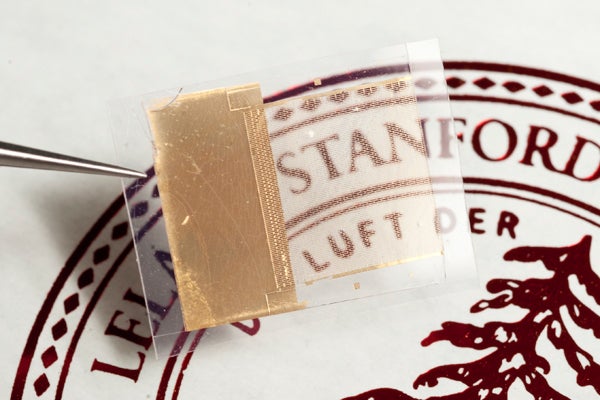|
View video here.
July 25, 2011
Stanford transparent batteries: seeing straight through to the future?
Stanford researchers have invented a transparent lithium-ion battery that is also highly flexible. It is comparable in cost to regular batteries on the market today, with great potential for applications in consumer electronics. By Stephanie Liou

The cost of a transparent battery could be similar to that of a regular battery, said Yi Cui, an associate professor of materials science and engineering and of photon science at SLAC National Accelerator Laboratory. (Photo by Linda A. Cicero / Stanford News Service) It sounds like something out of a cheesy science fiction movie, but thanks to new research by several Stanford scientists, transparent cell phones are one step closer to becoming a reality.
Several companies have successfully created partially transparent gadgets such as digital photo frames and cell phones with see-through keyboards. However, fully transparent e-book readers or cell phones have remained largely in the realm of conceptual art due to one last missing puzzle piece.
"If you want to make everything transparent, what about the battery?" said Yi Cui, an associate professor of materials science and engineering and of photon science at SLAC National Accelerator Laboratory, renowned for his work with batteries.
With graduate student Yuan Yang, who is the first author of the paper "Transparent lithium-ion batteries" in the July 25 edition of the Proceedings of the National Academy of Sciences, Cui set out to create a clear battery suitable for use in consumer electronics.
"I can make the battery more powerful, but I also want to make the battery look fancier," said Cui, who praised Yang for coming up with this unusual research idea.
Since key active materials in batteries cannot yet be made transparent or replaced with transparent alternatives, Yang and Cui realized that they had to find a way to construct a battery such that its nontransparent components were too small to be seen by the naked eye.
"If something is smaller than 50 microns, your eyes will feel like it is transparent," said Yang, because the maximum resolving power of the human eye is somewhere between 50 to 100 microns.
Yang and Cui devised a mesh-like framework for the battery electrodes, with each "line" in the grid being approximately 35 microns wide. Light passes through the transparent gaps between the gridlines; because the individual lines are so thin, the entire meshwork area appears transparent.
This was easier said than done. The pair finally came up with an ingenious three-step process that utilized low-cost, commonly available substances.
First, since regular materials such as copper or aluminum were out of the question, a transparent alternative had to be found. Yang and Cui settled upon a transparent, slightly rubbery compound known as polydimethylsiloxane (PDMS).
"PDMS is pretty cheap, and already being used in plastic surgery and contact lenses," said Yang. "But it is not conductive, so we had to deposit metals onto it to make it conductive."
To do so, PDMS was poured into silicon molds to create grid-patterned trenches. A metal film was evaporated over the trenches, creating a conductive layer.
The researchers then dropped a liquid slurry solution containing minuscule, nano-sized active electrode materials into the trenches.
Next, Yang developed a special transparent substance to be sandwiched between electrodes. He modified an existing gel electrolyte to make it serve double-duty as both an electrolyte and a separator. Since all of the materials used to make separators in regular batteries are nontransparent, this was a vital step.
By precisely placing an electrolyte layer between two electrodes, one functional battery is created. Multiple layers can be added in order to create a larger and more powerful battery.
As long as the gridlines are matched accurately, transparency is maintained. Yang and Cui's light transmittance tests showed a 62 percent transparency in visible light, and approximately 60 percent transparency even with three full cells stacked on top of each other. The entire battery is also highly flexible.
Perhaps best of all, the transparent battery is less expensive than one might expect.
"Its cost could be similar to those of regular batteries," said Cui. "Especially if we use low cost metals as current collectors, there is no reason this cannot be cheap."
The only current limitation is that the transparent battery is only about half as powerful as comparably sized lithium-ion counterparts.
"The energy density is currently lower than lithium batteries," said Yang. "It is comparable to nickel-cadmium batteries right now."
Most laptops and cell phones are powered by lithium-ion batteries, while nickel-cadmium batteries are often found in cameras and other less energy-intensive devices.
Yang and Cui are optimistic that advancements in materials science will enable the improvement of the energy density of the transparent battery. The manufacturing process is definitely scalable, and there is potential for commercial application, said Cui, who has filed a patent for the battery.
But wait, one might ask – what is the reason to have a transparent device, or even a transparent battery?
"It's very exciting for doing fundamental scientific research," said Cui. "You can study what is happening inside batteries since they are transparent now."
Grand contributions to science aside, though, there was definitely a bigger motivating force behind Yang and Cui's research.
"It just looks cool," said Cui. "I want to talk to Steve Jobs about this. I want a transparent iPhone!"
Yang's work is supported by the Stanford Graduate Fellowships Program in Science and Engineering. Funding for this research was provided by the King Abdullah University of Science and Technology (KAUST).
Sangmoo Jeong, Liangbing Hu, Hui Wu and Seok Woo Lee, all of Stanford, also contributed to this research.
Stephanie Liou is an intern at the Stanford News Service.
-30-
|